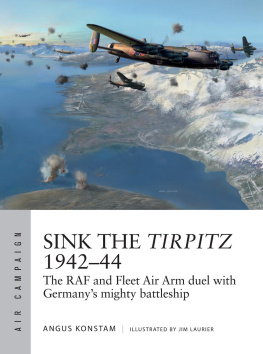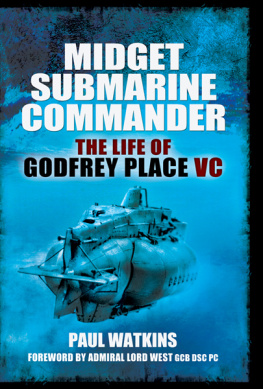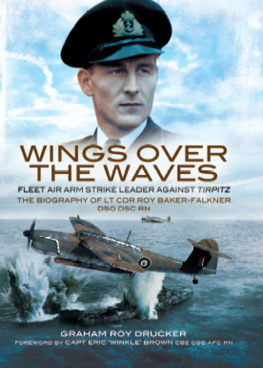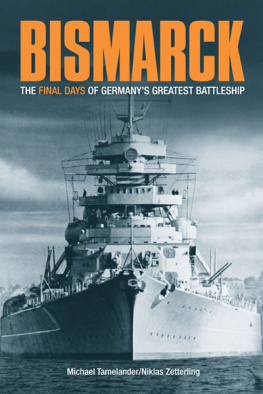HUNTING TIRPITZ
ROYAL NAVAL OPERATIONS AGAINST BISMARCKS SISTER SHIP
Britannia Naval Histories of World War II

Contents
This book is invariably to be kept locked up when not in use and is not to be taken outside the ship or establishment for which it is issued without the express permission of the Commanding Officer.
This book is the property of His Majestys Government.
It is intended for the use of Officers generally, and may in certain cases be communicated to persons in His Majestys Service below the rank of Commissioned Officer who may require to be acquainted with its contents in the course of their duties. The Officers exercising this power will be held responsible that such information is imparted with due caution and reserve.
Attention is called to the penalties attaching to any infraction of the Official Secrets Acts.
Director of Naval Construction Admiralty
31 March, 1949
P.03370/47
ebook edition first published in the United Kingdom in 2017 by University of Plymouth Press, Room 002, 18 Endsleigh Place, Drake Circus, Plymouth, Devon, PL4 8AA, United Kingdom.
eISBN 978-1-84102-405-9
University of Plymouth Press 2017
A CIP catalogue record of this book is available from the British Library. ISBN 978-1-84102-310-6
Publisher: Paul Honeywill
Commissioning Editor: Charlotte Carey
Series Editors: G. H. Bennett, J. E. Harrold, R. Porter and M. J. Pearce
The rights of this work have been asserted in accordance with the Crown Copyright, Designs and Patents Act 1988. All rights reserved. No part of this publication may be reproduced, without the prior written permission of UPP. Any person who carries out any unauthorised act in relation to this publication may be liable to criminal prosecution and civil claims for damages.
Historical content courtesy of Britannia Museum, Britannia Royal Naval College, Dartmouth, TQ6 0HJ.
Cover image Edward Stables 2012
The historical documents reproduced here appear as unedited text, apart from minor changes made to date formats and corrections to typing errors found in the original.

Britannia Royal Naval College, Dartmouth
Britannia Royal Naval College
A majestic landmark, which towers above the harbour town of Dartmouth in Devon, Britannia Royal Naval College was designed by royal architect Sir Aston Webb to project an image of British sea power. A fine example of Edwardian architecture, the College has prepared future generations of officers for the challenges of service and leadership since 1905.
The Britannia Museum opened in 1999 to safeguard the Colleges rich collection of historic artefacts, art and archives and promote greater public understanding of Britains naval and maritime heritage, as a key element in the development of British history and culture. It also aims to instill a sense of identity and ethos in the Officer Cadets that pass through the same walls as their forbears, from great admirals to national heroes, to royalty.
Britannia
Foreword Admiral Sir Mark Stanhope
With this welcome new series of Second World War battle summaries, history once again speaks to posterity.
There is much in this nations long and distinguished maritime and naval history upon which to reflect and celebrate. In so doing, we are reminded especially of our countrys inextricable dependency on the sea for our prosperity and security.
We are also reminded that, within an ever-changing security environment, the characteristics of the sea and the attributes of maritime forces prevail. Enduring truths that the story of the hard-won pursuit of the Tirpitz illustrates so clearly. A story of determination, innovation and heroism. A story which demonstrates graphically Tirpitz s strategic significance because of her potential to prevent the flow of trade; always the lifeblood of ours and Russias economies at a critical time. Consequently, the Tirpitz shaped the Admiraltys and British War Cabinets thinking perhaps for longer than any other capability or platform during the War.
Dr Bennetts introduction helpfully sets the naval staff historians accessible battle summaries in their wider context. Together, the Royal Navys attempts to render the Tirpitz unusable by deploying daring and imaginative raids, midget submarine attacks and Fleet Air Arm sorties are as much inspirational as they are instructive. Indeed, I would commend readers, when absorbing these engaging pages, to reflect upon another enduring truth; the qualities of human endeavour: qualities of courage, leadership and professionalism quietly, consistently and valiantly displayed for the nation and for freedom. Qualities that were tangible yesterday, are visible today and will be indispensable tomorrow.
I am most grateful to the Trustees of the Britannia Museum and the University of Plymouth Press for producing this immensely worthwhile series of battle summaries. The Britannia Naval Histories of World War II will be a valuable resource for anyone with either a professional, personal or even passing interest in British maritime and naval history.
Posterity should listen with attentiveness.

Introduction Dr G. H. Bennett
In 1941, the North Atlantic witnessed a desperate struggle as Germanys newest battleship Bismarck tried and failed to escape pursuing units of the Royal Navy. Making her sortie from the Baltic on 19 May 1941, Bismarck slipped into the North Atlantic via the GreenlandIceland gap in search of the convoys running from North America to the United Kingdom. The Royal Navy countered by deploying most of its capital ships in the Atlantic and the Gibraltar based Force H from the Western Mediterranean. On 24 May, the battlecruiser HMS Hood , the pride of the Royal Navy, and HMS Prince of Wales , Britains newest battleship, engaged Bismarck and her escorting heavy cruiser Prinz Eugen. The battle was over in a matter of minutes as HMS Hood was destroyed with the loss of all but three of her crew of 1,418, and HMS Prince of Wales , fighting on alone for 13 minutes, retired to shadowing distance after sustaining damage. It was a stunning success for the German Navy, but other major units of the Royal Navy were already closing with the German task force. Bismarck had sustained apparently minor damage to her fuel bunkers in the encounter, but in the midst of an Atlantic dominated by the Royal Navy, it was enough to terminate the operation.
It was decided that Bismarck should head for St. Nazaire, which had the only dock on the Atlantic coast capable of accommodating the mighty battleship. It was a perilous voyage with an uncertain end, even if Bismarck succeeded in making port. In port, on the French coast, Bismarck would be in range of R.A.F. Bomber Command. Prinz Eugen was detached from Bismarck as both ships companies prepared for a desperate race for safety. Aided by the vastness of the Atlantic, Bismarck succeeded in getting away momentarily from the shadowing British units. Reacquiring their target as Bismarck pushed steadily towards St. Nazaire, the Fleet Air Arm were able to deal a decisive blow: a torpedo strike from a Fairey Swordfish late in the evening of 26 May jammed Bismarck s rudder and condemned her to steam in circles, miles short of her intended destination. The following morning, British vessels engaged the Bismarck . Within 45 minutes, Bismarck s main armament had been silenced and British ships closed in to fire at her at point blank range. Almost two hours after the engagement had begun, at 1039, Bismarck slipped under the waves. The news was relayed to the Admiralty to be announced by the Prime Minister in the House of Commons. After Churchill had made the announcement, the sense of relief within the Government and the House of Commons was palpable. Within the Royal Navy there was satisfaction in accomplishing a job well done. Granted, HMS Hood had been lost, but equally Germanys newest and most powerful battleship had been sunk on her first war cruise.
Next page













